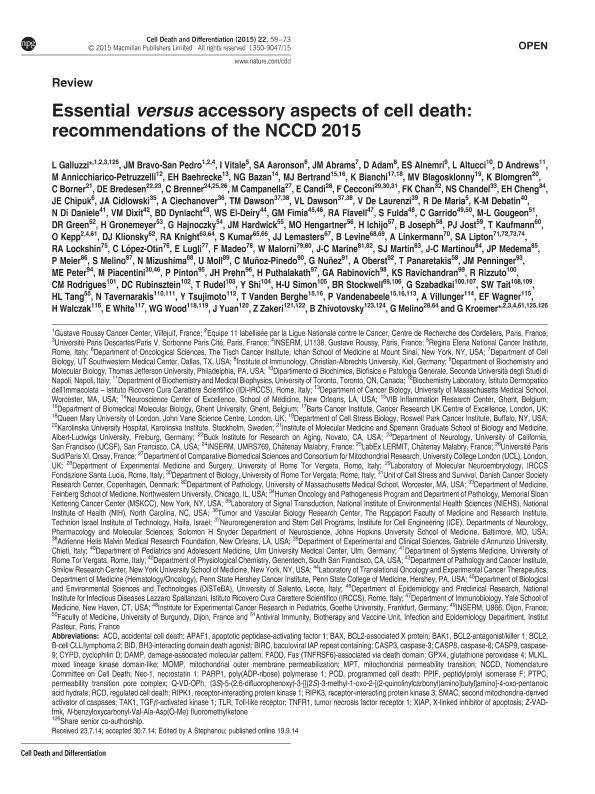Mostrar el registro sencillo del ítem
dc.contributor.author
Rabinovich, Gabriel Adrián

dc.contributor.author
Nomenclature Committee on Cell Death
dc.date.available
2016-03-04T17:52:49Z
dc.date.issued
2015-09-19
dc.identifier.citation
Rabinovich, Gabriel Adrián; Nomenclature Committee on Cell Death; Essential versus accessory aspects of cell death: recommendations of the NCCD 2015; Nature Publishing Group; Cell Death and Differentiation; 22; 1; 19-9-2015; 58-73
dc.identifier.issn
1350-9047
dc.identifier.uri
http://hdl.handle.net/11336/4624
dc.description.abstract
Cells exposed to extreme physicochemical or mechanical stimuli die in an uncontrollable manner, as a result of their immediate structural breakdown. Such an unavoidable variant of cellular demise is generally referred to as ?accidental cell death' (ACD). In most settings, however, cell death is initiated by a genetically encoded apparatus, correlating with the fact that its course can be altered by pharmacologic or genetic interventions. "Regulated cell death" (RCD) can occur as part of physiologic programs or can be activated once adaptive responses to perturbations of the extracellular or intracellular microenvironment fail. The biochemical phenomena that accompany RCD may be harnessed to classify it into a few subtypes, which often (but not always) exhibit stereotyped morphologic features. Nonetheless, efficiently inhibiting the processes that are commonly thought to cause RCD, such as the activation of executioner caspases in the course of apoptosis, does not exert true cytoprotective effects in the mammalian system, but simply alters the kinetics of cellular demise as it shifts its morphologic and biochemical correlates. Conversely, bona fide cytoprotection can be achieved by inhibiting the transduction of lethal signals in the early phases of the process, when adaptive responses are still operational. Thus, the mechanisms that truly execute RCD may be less understood, less inhibitable and perhaps more homogeneous than previously thought. Here, the Nomenclature Committee on Cell Death formulates a set of recommendations to help scientists and researchers to discriminate between essential and accessory aspects of cell death
dc.format
application/pdf
dc.language.iso
eng
dc.publisher
Nature Publishing Group

dc.rights
info:eu-repo/semantics/openAccess
dc.rights.uri
https://creativecommons.org/licenses/by/2.5/ar/
dc.subject
Cell Death
dc.subject
Apoptosis
dc.subject.classification
Inmunología

dc.subject.classification
Medicina Básica

dc.subject.classification
CIENCIAS MÉDICAS Y DE LA SALUD

dc.title
Essential versus accessory aspects of cell death: recommendations of the NCCD 2015
dc.type
info:eu-repo/semantics/article
dc.type
info:ar-repo/semantics/artículo
dc.type
info:eu-repo/semantics/publishedVersion
dc.date.updated
2016-03-30 10:35:44.97925-03
dc.identifier.eissn
1476-5403
dc.journal.volume
22
dc.journal.number
1
dc.journal.pagination
58-73
dc.journal.pais
Reino Unido

dc.journal.ciudad
Londres
dc.conicet.avisoEditorial
This work is licensed under a Creative Commons Attribution 3.0 Unported License. The images or other third party material in this article are included in the article’s Creative Commons license, unless indicated otherwise in the credit line; if the material is not included under the Creative Commons license, users will need to obtain permission from the license holder to reproduce the material.
dc.description.fil
Fil: Rabinovich, Gabriel Adrián. Consejo Nacional de Investigaciones Científicas y Técnicas. Instituto de Biología y Medicina Experimental. Fundación de Instituto de Biología y Medicina Experimental. Instituto de Biología y Medicina Experimental; Argentina
dc.description.fil
Fil: Nomenclature Committee on Cell Death. Equipe 11 Apoptose, Cancer et Immunité. Centre de Recherche des Cordeliers; Francia
dc.journal.title
Cell Death and Differentiation

dc.relation.alternativeid
info:eu-repo/semantics/altIdentifier/url/http://www.nature.com/cdd/journal/v22/n1/full/cdd2014137a.html
dc.relation.alternativeid
info:eu-repo/semantics/altIdentifier/url/http://www.ncbi.nlm.nih.gov/pmc/articles/PMC4262782/
dc.relation.alternativeid
info:eu-repo/semantics/altIdentifier/doi/https://doi.org/10.1038/cdd.2014.137
dc.relation.alternativeid
info:eu-repo/semantics/altIdentifier/url/http://www.nature.com/cdd/journal/v22/n1/pdf/cdd2014137a.pdf
Archivos asociados
